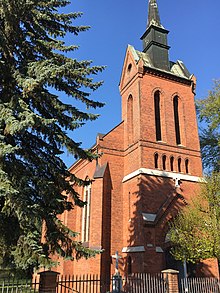St. Benno (Spremberg)
St. Benno in the Brandenburg town of Spremberg is the Roman Catholic parish church of the same parish in the diocese of Görlitz . Since 2016, the associated parish has also included the parishes of Forst (Lausitz) , Döbern , Schwarze Pump and Bloischdorf .
history
From the Christianization of Lausitz to the introduction of the Reformation in Spremberg, the Kreuzkirche was the parish church for the city's Christians. After the denominational split, no more Catholic services were held in Spremberg. A Roman Catholic community gradually emerged in the 19th century as a result of the influx of workers from predominantly Catholic areas, primarily as a result of industrialization in the cloth and glass industry. Starting in 1856, a service was held six times a year for the Catholic military members of the Spremberg garrison in the Georgenberg Chapel, which could also be attended by the other Catholics. After the garrison was relocated, no further permission was granted for further Catholic services. At the instigation of the Neuzell pastor Florian Birnbach, a missionary priest was appointed in 1868 by the Breslau prince-bishop, chaplain Wilhelm Lindner, who had previously worked in Naumburg am Bober .
In order to end the cramped conditions of the church service room and the pastor's apartment for rent, a piece of land in Bergstrasse in Spremberg was acquired by Lindner in 1870 and, so that the purchase could be carried out notarially in the name of the parish, with a deed dated July 17, 1870 the parish of Spremberg was established by the Prince-Bishop of Breslau, Heinrich Förster . On December 16, the Prussian King confirmed the erection in Versailles. As a result, the construction of a parish and school house in Bergstrasse was initiated and financed by numerous donors. On August 21, 1871, a small chapel was consecrated in the new rectory in honor of St. Benno .
After Pastor Lindner's death in 1877, there was no successor for him. Nevertheless, the construction of a church was pushed ahead and the foundation stone was laid in 1886. On May 11, 1887, the new church was assigned to the patronage of St. Benno by pastor Jende von Neuzelle. In the same year a pastor was appointed to Spremberg again, Augustin Sauer. The church was flooded in 1897, and several times thereafter until the Spree was regulated by the construction of the Bautzen dam due to its location in the Spreeaue.
In 1942, under Pastor Roman Adamski, a new painting and a redesign of the high altar , the windows in the chancel and later also the Marian altar were made. The last profound redesign took place in the years 1984–1987 by Pastor Klaus Trzewik under conditions of socialist shortage economy. Much of the original equipment was removed. In 1987 a new organ from the Sauer company was installed to mark the centenary of the church .
Building design
The simple brick building in the neo-Gothic style with an entrance facade facing the street is dominated by a transverse rectangular tower, which is closed off by a transverse saddle roof with attached ridge turrets. The church interior presents itself as a hall with three arched bays and a retracted choir with a 3/6 end.
The figure of St. Benno and St. John and Joseph received from the high altar and the tabernacle , as well as the images of the Way of the Cross and the baptismal font. Two late medieval altar wings with eight representations of saints are hung in the choir, which were originally installed in the Bloischdorf Church .
organ
The company W. Sauer Orgelbau from Frankfurt / Oder built a new organ for St. Benno in 1987 . Opus 2199 on the northeast gallery was Jörg Dutschke's masterpiece . In the square central field, which has the same width as the substructure with the gaming table , the 25 prospect pipes are set up in a V-shape. It is flanked by two elevated, rectangular pipe flat fields, in each of which five pipes continue the lines of the central field. The disposition is characterized by several aliquot registers and mixed voices and a few fundamental registers in neo-baroque style. The front-intensive grinding loading -instrument with mechanical key action has 13 sounding registers , the two manuals and pedals are distributed.
|
|
|
||||||||||||||||||||||||||||||||||||||||||||||||||||||||||||||||||||||||||||||
- Coupling : II / I, I / P, II / P
Web links
Individual evidence
- ↑ https://stadt-spremberg.de/index.php?ber=katalog&pos_top=4&pos_left=11&hk=20&uk=376&klick=3&tiefe=1&nr=119&nr1=127&ktm_nr2=547&no_popup=1&ktm_nr2=558&no_popup=1&no_popup=1
- ↑ https://www.kath-spremberg.de/kirchenansichten/2-uncategorised/11-geschichte-der-pfarrei.html
- ^ Georg Dehio : Handbook of the German art monuments : Brandenburg. Edited by Gerhard Vinken and others, reviewed by Barbara Rimpel. Deutscher Kunstverlag, Munich / Berlin 2012, ISBN 978-3-422-03123-4 , p. 1064.
- ^ Orgel Databank: Orgel in Spremberg , accessed on May 10, 2019.
Coordinates: 51 ° 34 ′ 27.6 " N , 14 ° 22 ′ 31" E

